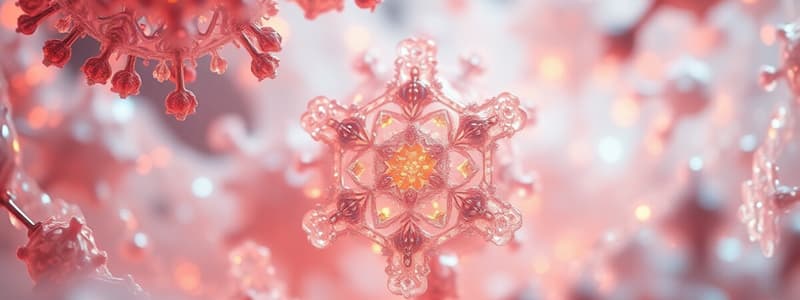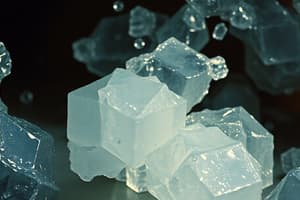Podcast
Questions and Answers
What is the primary reason metals are good conductors of heat and electricity?
What is the primary reason metals are good conductors of heat and electricity?
- High density of metal atoms
- Delocalized valence electrons (correct)
- Strong covalent bonds
- Presence of impurities
The bonding in metallic solids is primarily due to covalent bonds between atoms.
The bonding in metallic solids is primarily due to covalent bonds between atoms.
False (B)
What is the coordination number of an atom in a close packed structure?
What is the coordination number of an atom in a close packed structure?
6
Metals usually have __________ density of bonding due to the number of valence electrons available.
Metals usually have __________ density of bonding due to the number of valence electrons available.
Match the following metals with their melting points:
Match the following metals with their melting points:
What type of atomic arrangement is described by the sequence 'ABAB...'?
What type of atomic arrangement is described by the sequence 'ABAB...'?
Cubic Close Packing (ccp) requires a different arrangement of layers than Hexagonal Close Packing (hcp).
Cubic Close Packing (ccp) requires a different arrangement of layers than Hexagonal Close Packing (hcp).
What is the coordination number of atoms in both Hexagonal Close Packing and Cubic Close Packing structures?
What is the coordination number of atoms in both Hexagonal Close Packing and Cubic Close Packing structures?
In the face-centered cubic (fcc) unit cell, there are _____ atoms in total.
In the face-centered cubic (fcc) unit cell, there are _____ atoms in total.
Match the following packing arrangements with their corresponding features:
Match the following packing arrangements with their corresponding features:
Flashcards
Metallic Bonding
Metallic Bonding
The bonding in metals is due to delocalized valence electrons that are shared throughout the entire solid.
Close-Packed Layers
Close-Packed Layers
The most efficient way to arrange atoms in a solid, maximizing the number of nearest neighbors (coordination number) and minimizing the volume.
Coordination Number
Coordination Number
The number of nearest neighboring atoms surrounding an atom in a crystal structure.
Metallic Structures
Metallic Structures
Signup and view all the flashcards
Melting Point Correlation
Melting Point Correlation
Signup and view all the flashcards
Hexagonal Close Packing (HCP)
Hexagonal Close Packing (HCP)
Signup and view all the flashcards
Cubic Close Packing (CCP)
Cubic Close Packing (CCP)
Signup and view all the flashcards
Close Packing Efficiency
Close Packing Efficiency
Signup and view all the flashcards
Coordination Number (HCP/CCP)
Coordination Number (HCP/CCP)
Signup and view all the flashcards
FCC Unit Cell
FCC Unit Cell
Signup and view all the flashcards
Study Notes
Structures of Solids
- Solids can be crystalline or amorphous.
- Crystalline solids have ordered atomic arrangements, flat surfaces, and definite angles.
- Amorphous solids lack orderly structure.
Unit Cells
- The repeating unit in a crystalline solid is the unit cell.
- Unit cells can be chosen in various ways, but the smallest one that clearly shows symmetry is usually selected.
- Crystalline solids can be represented by a 3-dimensional array of points called a crystal lattice.
Cubic Unit Cells
- Primitive cubic: Lattice points only at the corners.
- Body-centered cubic: Lattice points at the corners and the center of the cell.
- Face-centered cubic: Lattice points at the corners and the center of each face.
Bonding in Solids
- Molecular solids: atoms or molecules held together by intermolecular forces (e.g., London dispersion, dipole-dipole, hydrogen bonds). Soft, low melting points.
- Covalent network solids: atoms held together by strong covalent bonds in extended networks or chains. Hard, high melting points. Examples include diamond, quartz, silicon carbide.
- Ionic solids: positive and negative ions held together by electrostatic attraction. Hard, brittle, high melting points. Examples include NaCl, CaCO3.
- Metallic solids: metal atoms held together by delocalized valence electrons (electron sea model). Good conductors, malleable and ductile, wide range of melting points varying with number of valence electrons.
Close Packed Structures
- Close packed layers are the most efficient arrangement of spheres in terms of volume.
- The most efficient types of close packing are hexagonal close packing (HCP) and cubic close packing (CCP or FCC).
- HCP and CCP are 74% efficient, compared to the other types of structures.
Crystal Structure of Metals
- Metals can have hexagonal close-packed, cubic closed-packed or body-centered cubic structures.
- Each atom typically has 8 or 12 adjacent atoms.
- The bonding in metals is strong due to a 'sea' of delocalized valence electrons.
Density Calculations
- Density depends on crystal structure and the number of atoms in the unit cell.
- Calculations involve mass, volume, number of atoms and Avogadro's number.
Studying That Suits You
Use AI to generate personalized quizzes and flashcards to suit your learning preferences.



